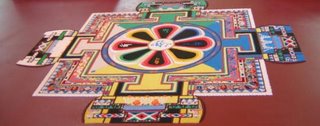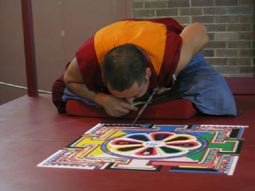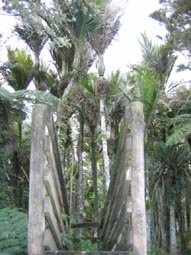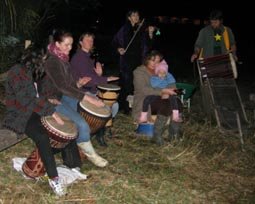 It was a completely different atmosphere at the Sand Mandala on the afternoon of its dissolution. For one thing the room was over heated and stuffy with the smell of too many bodies, both the unwashed and the overly-perfumed varieties, crammed into a small space. Small children grew fractious at being held back from destroying the completed mandala ahead of schedule.
It was a completely different atmosphere at the Sand Mandala on the afternoon of its dissolution. For one thing the room was over heated and stuffy with the smell of too many bodies, both the unwashed and the overly-perfumed varieties, crammed into a small space. Small children grew fractious at being held back from destroying the completed mandala ahead of schedule.Once everyone had admired and photographed the finished mandala there was a lengthy session of thank you's, speeches and presentations of mandala posters and long silk scarves the colour of french vanilla ice cream. The youngest monk, the one with the sparse but lengthy handlebar moustache and the heavy gold watch, pulled out a tiny video camera from the folds of his robes and surreptiously filmed the audience before tucking the technology away.
Geshe-La gave a talk about the meaning of the mandala, mostly recapping what he said at the opening ceremony, and about the ritual about to commence. To make, and to witness the making of the mandala is to accumulate merit by imprinting loving-kindness and altruism onto our minds and remove obstacles to compassion. The dissolution rituals energise the Chenrezig mandala by giving the sand to running water. The spirits are made happy by this gift, Geshe-La said. He also said that even though these aspects of Buddhism sound like imagination and mythology, if you study Buddhism seriously you will find it is rational and logical.
Then the monks launched into a comparatively short session of deep droning chants punctuated with bell ringing. This is the third time I've listened to them chanting and it is starting to sound pleasantly familiar so my perception of brevity might be influenced by not feeling so alien. Anyway, it didn't seem like long before the three of them stood up and stood at the north side of the mandala, did a bit more chanting and began to break it up. I was watching the faces of the two monks who had spent the past three weeks creating it and I saw no hint of attachment to their work nor reluctance to destroy it. I thought about my friend who said she wouldn't attend the closing because she would be too upset by the dissolution.
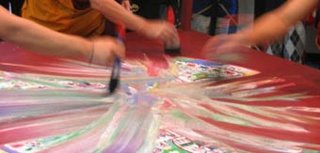
First they scattered grains of polished rice across the intricate face of the mandala, then using first their hands and then big soft paint brushes the monks swept the coloured grains from the edge into the centre in a more or less symmetrical process. Their paths blurred then obliterated the monkeys chased by dragons, the little goats and green horses, the cloud patterns and lotus petals, the dancers and meditators, the fountains and flames: all the details that I'd watched emerge as the design grew ever more complex as it expanded out from the relatively simple central shapes.
A pile of greenish grey sand grew up in the centre of the platform and was finally dispersed into the monk's special vessels and a hilarious assortment of containers presented by members of the audience. Glass jars and metal bowls, ziplock baggies and leather wallets, paper bags from the shop downstairs and a special little box: no one was turned away without a small handful of the grains charged with all the compassion of the mandala.
 Then we all drove out to the boat ramp at Onerahi (a harbourside suburb) and there recreated a ritual space on a blue tarpaulin facing the sea. Once everything was in place (including a huge photo of His Holiness the Dalai Lama) and everyone had a smouldering stick of incense, another round of chanting began, enlivened this time with not only bells but drum, cymbals and a conchshell horn.
Then we all drove out to the boat ramp at Onerahi (a harbourside suburb) and there recreated a ritual space on a blue tarpaulin facing the sea. Once everything was in place (including a huge photo of His Holiness the Dalai Lama) and everyone had a smouldering stick of incense, another round of chanting began, enlivened this time with not only bells but drum, cymbals and a conchshell horn. During this part of the ritual a motor boat pulled in and was hauled onto the back of a trailer right in front of the monks who didn't seem to miss a beat. A few minutes later, behind them a big and beautifully carved waka (Maori canoe) drove past on a trailer and our little crowd was expanded by a few of the interested waka ama crew and their families. Then the monks led us all in a procession down the boat ramp while they continued to ring bells, bash cymbals and blow the horn
 festively.
festively.Geshe La waded into the water and ceremoniously tipped all the remaining sand mandala grains into the harbour turning the water the same greenish hue for a moment. Finally everyone threw flowers in after the sand and watched them float out into the harbour. I felt sure the spirits were made as happy by receiving our gifts as we were by giving them.


